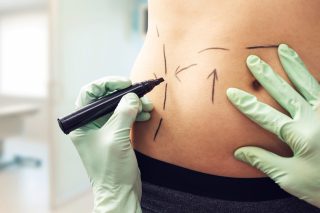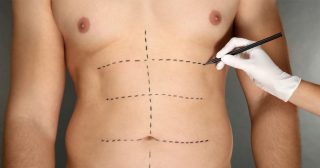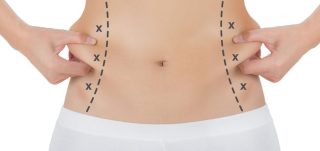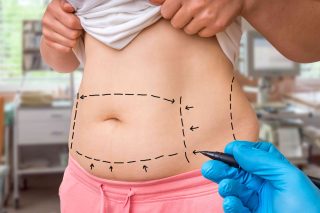Liposuction In Islamabad
Liposuction is a surgical procedure that uses a suction technique to remove fat from specific areas of the body, such as the abdomen, hips, thighs, buttocks, arms or neck. Liposuction also shapes (contours) these areas. Other names for liposuction include lipoplasty and body contouring.
Liposuction isn’t typically considered an overall weight-loss method or a weight-loss alternative. If you’re overweight, you’re likely to lose more weight through diet and exercise or through bariatric procedures — such as gastric bypass surgery — than you would with liposuction.
You may be a candidate for liposuction if you have too much body fat in specific spots but otherwise have a stable body weight.
Why it’s done
Liposuction is used to remove fat from areas of the body that haven’t responded to diet and exercise, such as the:
- Abdomen
- Upper arms
- Buttocks
- Calves and ankles
- Chest and back
- Hips and thighs
- Chin and neck
In addition, liposuction can sometimes be used for breast reduction or treatment of gynecomastia.
When you gain weight, fat cells increase in size and volume. In turn, liposuction reduces the number of fat cells in a specific area. The amount of fat removed depends on the appearance of the area and the volume of fat. The resulting contour changes are generally permanent — as long as your weight remains stable.
After liposuction, the skin molds itself to the new contours of the treated areas. If you have good skin tone and elasticity, the skin is likely to appear smooth. If your skin is thin with poor elasticity, however, the skin in the treated areas may appear loose.
Liposuction doesn’t improve cellulite dimpling or other skin surface irregularities. Likewise, liposuction doesn’t remove stretch marks.
To be a candidate for liposuction, you must be in good health without conditions that could complicate surgery such as restricted blood flow, coronary artery disease, diabetes or a weak immune system.
Risks
As with any major surgery, liposuction carries risks, such as bleeding and a reaction to anesthesia. Possible complications specific to liposuction include:
-
Contour irregularities
Your skin may appear bumpy, wavy or withered due to uneven fat removal, poor skin elasticity and unusual healing. These changes may be permanent. Damage beneath the skin from the thin tube (cannula) that’s used during liposuction may give the skin a permanent spotted appearance.
-
Fluid accumulation
Temporary pockets of fluid (seromas) can form under the skin. This fluid may need to be drained with a needle.
-
Numbness
You may feel temporary or permanent numbness in the affected area. Temporary nerve irritation also is possible.
-
Infection
Skin infections are rare but possible. A severe skin infection may be life-threatening.
-
Internal puncture
Rarely, a cannula that penetrates too deeply may puncture an internal organ. This may require emergency surgical repair.
-
Fat embolism
Pieces of loosened fat may break away and become trapped in a blood vessel and gather in the lungs or travel to the brain. A fat embolism is a medical emergency.
-
Kidney and heart problems
Shifts in fluid levels as fluids are being injected and suctioned out can cause potentially life-threatening kidney, heart and lung problems.
-
Lidocaine toxicity
Lidocaine is an anesthetic often administered with fluids injected during liposuction to help manage pain. Although generally safe, in rare circumstances, lidocaine toxicity can occur, causing serious heart and central nervous system problems.
The risk of complications increases if the surgeon is working on larger surfaces of your body or doing multiple procedures during the same operation. Talk to your surgeon about how these risks apply to you.
How you prepare
Food and medications
Before the procedure, discuss with your surgeon what to expect from the surgery. Your surgeon will review your medical history, and ask about any medical conditions you may have and any medications, supplements or herbs you may be taking.
Your surgeon will recommend that you stop taking certain medications, such as blood thinners at least three weeks prior to surgery. You may also need to get certain lab tests before your procedure.
Other precautions
If your procedure requires the removal of only a small amount of fat, the surgery may be done in an office setting. If a large amount of fat will be removed — or if you plan to have other procedures done at the same time, the surgery may take place in a hospital followed by an overnight stay. In either case, arrange for someone to drive you home and stay with you for at least the first night after the procedure.
What you can expect
Before the procedure
Tumescent liposuction
Before your liposuction procedure, the surgeon may mark circles and lines on the areas of your body to be treated. Photos also may be taken so that before and after images can be compared.
How your liposuction procedure is done depends on the specific technique that’s used. Your surgeon will select the appropriate technique based on your treatment goals, the area of your body to be treated, and whether you have had other liposuction procedures in the past.
- Tumescent liposuction. This is the most common type of liposuction. The surgeon injects a sterile solution, a mixture of salt water, which aids fat removal, an anesthetic (lidocaine) to relieve pain and a drug (epinephrine) that causes the blood vessels to constrict into the area that’s being treated. The fluid mixture causes the affected area to swell and stiffen.
The surgeon then makes small cuts into your skin and inserts a thin tube called a cannula under your skin. The cannula is connected to a vacuum that suctions fat and fluids from your body. Your body fluid may be replenished through an intravenous (IV) line.
- Ultrasound-assisted liposuction (UAL).This type of liposuction is sometimes used in conjunction with traditional liposuction. During UAL, the surgeon inserts a metal rod that emits ultrasonic energy under your skin. This ruptures the fat-cell walls and breaks down the fat for easier removal. A new generation of UAL called VASER-assisted liposuction uses a device that may improve skin contouring and reduce the chance of skin injuries.
- Laser-assisted liposuction (LAL).This technique uses high-intensity laser light to break down fat for removal. During LAL, the surgeon inserts a laser fiber through a small incision in the skin and emulsifies fat deposits. The fat is then removed via a cannula.
- Power-assisted liposuction (PAL).This type of liposuction uses a cannula that moves in a rapid back-and-forth motion. This vibration allows the surgeon to pull out tough fat more easily and faster. PAL may sometimes cause less pain and swelling and can allow the surgeon to remove fat with more precision. Your surgeon may select this technique if large volumes of fat need to be removed or if you’ve had a previous liposuction procedure.
During the procedure
Some liposuction procedures may require only local or regional anesthesia limited to a specific area of your body. Other procedures may require general anesthesia, which induces a temporary state of unconsciousness. You may be given a sedative, typically through an IV injection, to help you remain calm and relaxed.
The surgical team will monitor your heart rate, blood pressure and blood oxygen level throughout the procedure. If you are given local anesthesia and feel pain during the procedure, tell your surgeon. The medication or motions may need adjustment.
The procedure may last up to several hours, depending on the extent of fat removal.
If you’ve had general anesthesia, you’ll wake in a recovery room. You’ll typically spend at least a few hours in the hospital or clinic so that medical personnel can monitor your recovery. If you’re in a hospital, you may stay overnight to make sure that you’re not dehydrated or in shock from fluid loss.
After the procedure
Expect some pain, swelling and bruising after the procedure. Your surgeon may prescribe medication to help control the pain and antibiotics to reduce the risk of infection.
After the procedure, the surgeon may leave your incisions open and place temporary drains to promote fluid drainage. You usually need to wear tight compression garments, which help reduce swelling, for a few weeks.
You may need to wait a few days before returning to work and a few weeks before resuming your normal activities — including exercise.
During this time, expect some contour irregularities as the remaining fat settles into position.
Results
After liposuction, swelling typically subsides within a few weeks. By this time, the treated area should look less bulky. Within several months, expect the treated area to have a leaner appearance.





